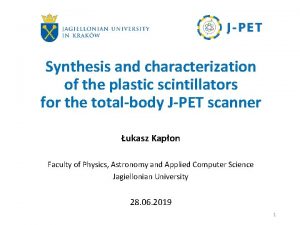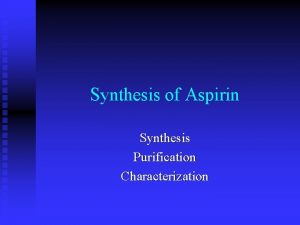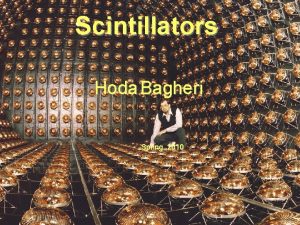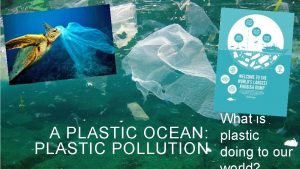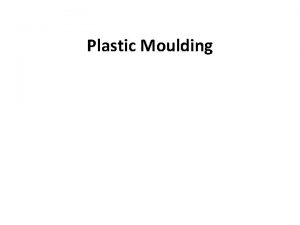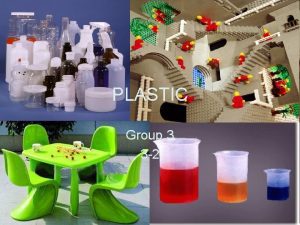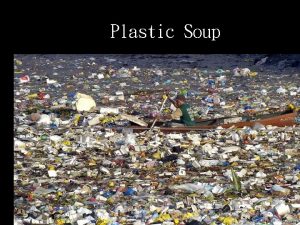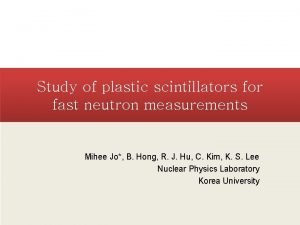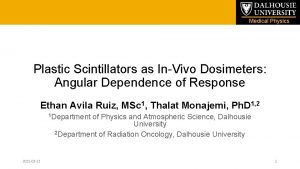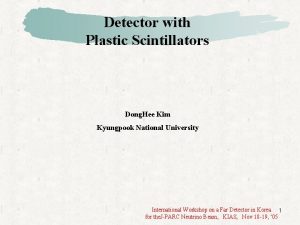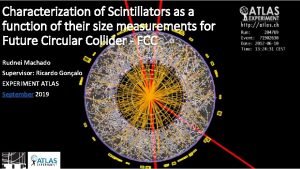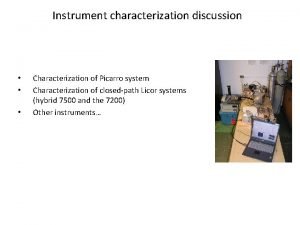Synthesis and characterization of the plastic scintillators for









![Results Light yield [photons/Me. V] Decay time [ns] Emission maximum [nm] Polystyrene 2% PPO Results Light yield [photons/Me. V] Decay time [ns] Emission maximum [nm] Polystyrene 2% PPO](https://slidetodoc.com/presentation_image_h2/3ab72ba0a6fe1f5b07a6bc02faa846c5/image-10.jpg)


![Plastic scintillator strips used in JPET Dimensions [mm 3] Used in J-PET prototype BC-420 Plastic scintillator strips used in JPET Dimensions [mm 3] Used in J-PET prototype BC-420](https://slidetodoc.com/presentation_image_h2/3ab72ba0a6fe1f5b07a6bc02faa846c5/image-13.jpg)



![Summary results Scintillator 6 x 24 x 1000 mm^3 TAL for LR scan [cm] Summary results Scintillator 6 x 24 x 1000 mm^3 TAL for LR scan [cm]](https://slidetodoc.com/presentation_image_h2/3ab72ba0a6fe1f5b07a6bc02faa846c5/image-17.jpg)


- Slides: 19

Synthesis and characterization of the plastic scintillators for the total-body J-PET scanner Łukasz Kapłon Faculty of Physics, Astronomy and Applied Computer Science Jagiellonian University 28. 06. 2019 1

Outline 1) Chemistry of plastic scintillators 2) Optical properties measurement: - light yield - emission spectra - decay time 3) Technical attenuation length of long plastic scintillator strips 2

Motivation • Develop plastic scintillators with high light transparency for J-PET construction. • Measure properties of commercial scintillators and choose the best for prototypes building. 3

Scintillation Principles: light emission mechanism 4

Scintillation Principles: chemical components 5

Scintillation Principles: cell casting polymerization 1. fast heating from room temperature 20 °C to 60 °C in 1 hour, 40 °C/h, 2. slow heating from 60 °C to 180 °C in 60 hours, 2 °C/h, 3. polymerization in 180 °C during 20 hours, 4. cooling from 180 °C to 90 °C in 30 hours, 3 °C/h, 5. first annealing in 90 °C for 4 hours, 6. cooling from 90 °C to 60 °C in 10 hours, 3 °C/h, 7. second annealing in 60 °C for 4 hours, 8. cooling from 60 °C to 20 °C room temperature in 10 hours, 4 °C/h. 6

Scintillation Principles: light yield of scintillators Light yield (LY) is a conversion efficiency of radioactive energy deposited in scintillator into light and is expressed in light photons generated per megaelectronvolt of deposited energy (photons/Me. V) by radiation quanta or particle. Comparing light yield of produced plastic scintillators to light yield of anthracene or stilbene crystal scintillators is known as relative light yield. Amax scintillator – middle of Compton edge for sample Amax stilbene – middle of Compton edge for sdandard 7

Scintillation Principles: emission and absorption spectra 1 -4 wt. % p-Terphenyl + POPOP ~0. 05 wt. % Absorption (green) and emission (red) spectra of two fluorescent substances commonly used in plastic scintillators p-Terphenyl emission spectrum overlaps with POPOP absorption spectrum Emission spectrum of plastic scintillator with p-Terphenyl and POPOP 8

Scintillation Principles: light pulse properties Decay time can be defined as time over which the light signal from scintillator decreases to 1/e of its maximum value. To measure decay time of plastic scintillators time-correlated single photon counting (TCSPC) was used. where following symbols denote: K - normalization constant Θ – time of the gamma quantum interaction with scintillator t - time td - decay time of the final light emission tr - average time of the energy transfer to the wavelength shifter σ - standard deviation reflects total uncertainty of light emission from scintillator and TCSPC components: excitation diode, photomultiplier tube and electronics. 9
![Results Light yield photonsMe V Decay time ns Emission maximum nm Polystyrene 2 PPO Results Light yield [photons/Me. V] Decay time [ns] Emission maximum [nm] Polystyrene 2% PPO](https://slidetodoc.com/presentation_image_h2/3ab72ba0a6fe1f5b07a6bc02faa846c5/image-10.jpg)
Results Light yield [photons/Me. V] Decay time [ns] Emission maximum [nm] Polystyrene 2% PPO 0. 03 POPOP 0. 03 bis-MSB 11200 1. 8 423 Polystyrene 2% BPBD 0. 06 POPOP 10770 1. 51 422 BC-420 polyvinyltoluene 10000 1. 5 391 EJ-200 polyvinyltoluene 10000 2. 1 425 Chemical composition 10

Commercial plastic scintillators 11

Technical attenuation length • The aim of this measurement was to determine technical light attenuation length of plastic scintillator strips used for J-PET modules construction. • The technical attenuation length (TAL) of a plastic scintillator bar is defined as the length of scintillator reducing the light signal by a factor of e and depending upon: Ø bulk transmission of the scintillator, Ø scintillator thickness, Ø shape of scintillator, Ø reflective property of the surfaces. 500 to 1000 mm long scintillators A 1 – amplitude x - distance from light detector t 1 - technical attenuation length y 0 - background 12
![Plastic scintillator strips used in JPET Dimensions mm 3 Used in JPET prototype BC420 Plastic scintillator strips used in JPET Dimensions [mm 3] Used in J-PET prototype BC-420](https://slidetodoc.com/presentation_image_h2/3ab72ba0a6fe1f5b07a6bc02faa846c5/image-13.jpg)
Plastic scintillator strips used in JPET Dimensions [mm 3] Used in J-PET prototype BC-420 EJ-230 BC-404 EJ-200 UPS-923 A SP 32 Epic PS 5 x 19 x 300 7 x 19 x 500 6 x 24 x 1000 6 x 24 x 1000 24 strips small barrel with PMTs 192 strips big barrel with PMTs 312 strips modular PET with Si. PMs 1 m long with WLS and Si. PMs Research for one meter module with Si. PMs Data from manufacturers Decay time [ns] 1. 5 1. 8 2. 1 3. 3 2. 5 2. 4 Light output [% of anthracene] 64 64 68 64 56 56 50 -60 Wavelength of maximum emission [nm] 391 408 425 415 Light attenuation length [cm] 110 120 160 380 400 NA 200 Polymer base PVT PVT PS PS PS 13

Overlapping of 365 nm UV lamp emission spectra and scintillator absorption UV light 14

Setup for TAL measurements In measurement following equipment was used: UV lamp with 365 nm wavelength of maximum emission; silicon PIN photodiode BPW 34 B with 2. 73 x 2. 73 mm 2 active area; digital multimeter Rigol DM 3064; power supply ZUE 5352 M; aluminium rail with 8 mm diameter holes drilled every 50 mm. 15

Summary results 16
![Summary results Scintillator 6 x 24 x 1000 mm3 TAL for LR scan cm Summary results Scintillator 6 x 24 x 1000 mm^3 TAL for LR scan [cm]](https://slidetodoc.com/presentation_image_h2/3ab72ba0a6fe1f5b07a6bc02faa846c5/image-17.jpg)
Summary results Scintillator 6 x 24 x 1000 mm^3 TAL for LR scan [cm] TAL for RL scan [cm] EJ-200 PS 56 145. 74 ± 11. 65 149. 59 ± 4. 09 EJ-200 PS 57 163. 55 ± 7. 84 145. 65 ± 4. 67 UPS-923 A PS 1 62. 59 ± 1. 78 61. 26 ± 0. 85 UPS-923 A PS 2 69. 45 ± 1. 91 66. 63 ± 0. 76 Epic PS 1 32. 25 ± 1. 73 36. 17 ± 0. 93 Epic PS 2 41. 11 ± 1. 56 41. 25 ± 1. 04 SP 32 PS 1 22. 67 ± 0. 76 23. 22 ± 0. 60 SP 32 PS 2 24. 79 ± 0. 67 23. 92 ± 0. 64 TAL from specification [cm] 380 400 200 NA 17

Summary • Plastic scintillators with the different chemical compositions were synthesized. • Time-temperature cycles were established for polymerization in small cylinders as well as for polymerization in the glass mold allowing to manufacture plastic scintillator strips. • Spectroscopic and optical properties of these polystyrene scintillators were measured. Relative light output, decay time, emission spectra were measured to develop best composition. • Technical attenuation lengths were measured to choose the best scintillator for J-PET construction. 18

Thank you 19
 Plastic scintillators: chemistry and applications
Plastic scintillators: chemistry and applications Chemical properties of aspirin
Chemical properties of aspirin Meaning of direct characterization
Meaning of direct characterization Direct indirect characterization
Direct indirect characterization Formuö
Formuö Typiska novell drag
Typiska novell drag Tack för att ni lyssnade bild
Tack för att ni lyssnade bild Returpilarna
Returpilarna Shingelfrisyren
Shingelfrisyren En lathund för arbete med kontinuitetshantering
En lathund för arbete med kontinuitetshantering Kassaregister ideell förening
Kassaregister ideell förening Tidbok för yrkesförare
Tidbok för yrkesförare Anatomi organ reproduksi
Anatomi organ reproduksi Vad är densitet
Vad är densitet Datorkunskap för nybörjare
Datorkunskap för nybörjare Stig kerman
Stig kerman Hur skriver man en debattartikel
Hur skriver man en debattartikel För och nackdelar med firo
För och nackdelar med firo Nyckelkompetenser för livslångt lärande
Nyckelkompetenser för livslångt lärande Påbyggnader för flakfordon
Påbyggnader för flakfordon
